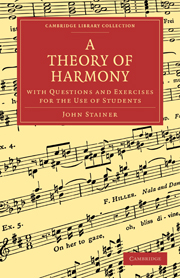Summary
A summary of the whole theory may not be useless. The following are the facts used for its ground-work:—
294. That the succession of sounds called the scale is conventional. It can be proved that it has varied from time to time during the progress of the art of music, and there is a probability that it will in future time be changed in its character. The ingenious efforts of scientific men to divide the octave into more than twelve parts will, possibly, lead to this result.
295. That at any given period in the history of the practice of music, chords have been made up by combining certain sounds of the scale at that time in use.
296. That any theory of harmony must, if true, be built upon the scale as in use at the time it is written.
297. That the third is the most harmonious interval, and that chords are combinations of thirds, and as such can be systematically arranged and catalogued.
298. That inasmuch as chords are a combination of sounds of a scale, every chord must be in a key, or at most, in two closely allied keys.
299. That the note of a key-scale on which a chord is built is its ground-note, and that by the word ground-note it is only intended to express this key-relationship between a certain note and those notes combined with it in various ways.
300. That relative chords are the common chords which can be made out of the diatonic scale, and relative keys the scales which they represent.
301. That the succession of chords is much influenced by this relation of key.
- Type
- Chapter
- Information
- A Theory of HarmonyWith Questions and Exercises for the Use of Students, pp. 165 - 169Publisher: Cambridge University PressPrint publication year: 2009First published in: 1876



